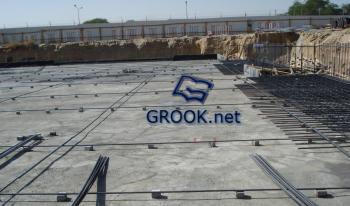Main menu
You are here
Concrete cover
Concrete cover

Concrete cover in reinforced concrete, the least distance between the surface of embedded reinforcement and the outer surface of the concrete. (ACI 130) The concrete cover depth can be measured with a cover meter.
Purpose of provision of concrete cover
- to protect the reinforcement bars from environmental effects to prevent corrosion.
- to protect the reinforcement bars from fire.
- to give reinforcing bars sufficient embedment to enable them to be stressed without slipping.
Guidelines
The amount of cover depth that needs to be provided is usually based on the exposure conditions that the structure is likely to be subjected. The Indian Concrete Code mandates the following:
| Exposure Condition |
Nominal Cover (mm) |
|---|---|
| Mild | 25 |
| Moderate | 30 |
| Severe | 45 |
| Very Severe | 50 |
| Extreme | 75 |
Other national codes also specify minimum cover requirements based on their respective local exposure conditions.
| Country | Concrete Code |
Range of Concrete Cover (mm) |
|---|---|---|
| UK | BS:8110 | 25-50 |
| EU | EN 1992 (EC2) | diameter +10 - 55 |
| USA | ACI:318 | 40-50 |
| Australia | AS:3600 | 15-30 |
Paradox
Large cover depths (50–75 mm) are required to protect reinforcement against corrosion in aggressive environments, but thick cover leads to increased crack widths in flexural reinforced concrete members. Large crack-widths (greater than 0.3 mm) permit ingress of moisture and chemical attack to the concrete, resulting in possible corrosion of reinforcement and deterioration of concrete. Therefore, thick covers defeat the very purpose for which it is provided. There is a need for judicious balance of cover depth and crack width requirements.
A possible economical solution for this paradox is the placing of a second layer of non corrosive reinforcement like stainless steel rebars or meshes or FRP rebars in the concrete cover to distribute the cracks.

